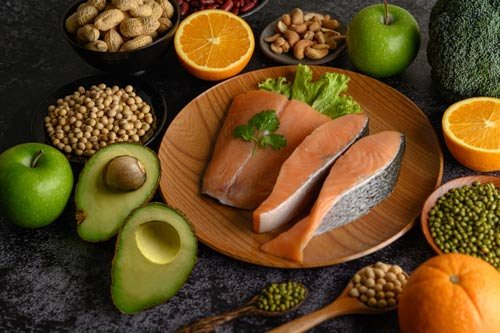Do you eat fish once in a day? if yes, you’re doing a great job. The creators of recipe to cook always motivate people to eat good food. That is one of the main reasons why, we incorporate healthy foods for longevity in our blog. Here is another such article for our loving readers. No waiting, this blog content is about Omega-3 foods. Let us take a deep dive into it.
Ready. Steady. and here we go!
What are Omega-3?
Omega-3 fatty acids are PolynsaUturated Fatty Acids (PUFA) that are beneficial to human health. They are classified as essential fatty acids, which means that the body cannot produce them and must obtain them through diet.

Omega-3 fatty acids are classified into three types: alpha-linolenic acid (ALA), eicosapentaenoic acid (EPA), and docosahexaenoic acid (DHA) (DHA). ALA can be found in plant-based foods such as flaxseeds, chia seeds, and walnuts, whereas EPA and DHA can be found primarily in fatty fish such as salmon, mackerel, and sardines. This is in the sense means that, most of the omega 3 foods are comprised of fishes.
17 Essential Omega-3 Foods
Omega-3 fatty acids are essential fats that contribute to overall health and lower the risk of chronic diseases. The following are 17 foods high in omega-3 fatty acids:
1. Salmon

Salmon is high in omega-3 fatty acids, particularly EPA and DHA. Eating salmon and other fatty fish on a regular basis is an excellent way to boost your intake of these essential fatty acids. A 100-gram serving of salmon contains about 2 grammes of omega-3 fatty acids, which is more than the daily recommended amount for most adults.
2. Sardines

Sardines have a high concentration of omega-3 fatty acids, particularly EPA and DHA. They also have essential nutrients like protein, vitamin D, and calcium. Consuming sardines and other fatty fish on a regular basis is an excellent way to increase your intake of these essential fatty acids. A typical serving of canned sardines contains about 1 gramme of omega-3 fatty acids when compared to other food sources.
3. Mackerel

Mackerel is a high-quality source of omega-3 fatty acids. It is high in EPA (eicosapentaenoic acid) and DHA (docosahexaenoic acid), two of the most important omega-3 fatty acids for human health.
Omega-3 fatty acids are essential fats that are essential for overall health, particularly brain health, cardiovascular health, and inflammation reduction in the body. Eating omega-3 fatty acid-rich foods, such as mackerel, can provide numerous health benefits.
In addition to mackerel, other oily fish like salmon, sardines, and trout are high in omega-3 fatty acids.
4. Tuna

Tuna is high in omega-3 fatty acids, especially the long-chain omega-3 fatty acids EPA (eicosapentaenoic acid) and DHA (docosahexaenoic acid).
The amount of omega-3s in tuna, however, varies depending on the species and method of preparation. Fresh or frozen tuna, for example, contains more omega-3s than canned tuna. Furthermore, some tuna species, such as bluefin tuna, may contain higher levels of mercury, which can be harmful in large quantities.
As a result, it is advised to consume tuna in moderation and to select sustainably caught sources. Other omega-3 fatty acid sources that can be included in a healthy diet include salmon, sardines, and mackerel.
5. Trout

Trout is also high in omega-3 fatty acids, especially the long-chain omega-3 fatty acids EPA (eicosapentaenoic acid) and DHA (docosahexaenoic acid). It is a freshwater fish that is frequently regarded as a healthy and nutritious food. They are high in protein, vitamins, and minerals, in addition to omega-3 fatty acids.
The amount of omega-3s in trout, like in other fish, varies depending on the species, the environment in which it was raised or caught, and the method of preparation. Wild-caught trout is thought to have higher omega-3 levels than farm-raised trout.
Trout can be incorporated into a healthy diet to increase omega-3 intake and reap the associated health benefits.
6. Flaxseed

Flaxseed contains omega-3 fatty acids, particularly alpha-linolenic acid (ALA), a plant-based omega-3. The long-chain omega-3 fatty acids EPA (eicosapentaenoic acid) and DHA (docosahexaenoic acid) found in oily fish such as salmon and mackerel are precursors to ALA. However, because the human body’s ability to convert ALA to EPA and DHA is limited, it may not provide the same health benefits as consuming EPA and DHA directly from fish or fish oil.
Despite this limitation, flaxseed is still regarded as a healthy food due to its high fibre content and other beneficial nutrients like lignans and antioxidants. It can be included in a healthy diet by adding ground flaxseed to smoothies, yoghurt, or oatmeal, or by using it as a supplement.
7. Chia seeds

Chia seeds are high in omega-3 fatty acids, especially alpha-linolenic acid (ALA), a plant-based omega-3. Like flaxseeds, they are high in dietary fibre, antioxidants, and other essential nutrients. They can be mixed into smoothies, yoghurt, oatmeal, or used in baking as a vegan egg substitute.
While chia seeds do contain omega-3s, the human body’s ability to convert ALA to the long-chain omega-3s EPA (eicosapentaenoic acid) and DHA (docosahexaenoic acid) is limited. As a result, it may not provide the same health benefits as getting EPA and DHA from fish or fish oil. However, because of their other nutrient content, incorporating chia seeds into a healthy diet can still provide numerous health benefits.
8. Walnuts

Walnuts are high in omega-3 fatty acids, especially alpha-linolenic acid (ALA), a plant-based omega-3. They are high in protein, dietary fibre, vitamins, and minerals, in addition to omega-3s. They’re a versatile snack that can also be added to salads, oatmeal, or baked goods.
While walnuts do contain omega-3s, the human body’s ability to convert ALA to the long-chain omega-3s EPA (eicosapentaenoic acid) and DHA (docosahexaenoic acid) is limited. As a result, it may not provide the same health benefits as getting EPA and DHA from fish or fish oil. However, due to their other nutrient content, incorporating walnuts into a healthy diet can still provide numerous health benefits.
9. Almonds

Almonds contain a significant amount of omega-3 fatty acids. They also comprises of some ALA (alpha-linolenic acid), a plant-based omega-3, the amount is small in comparison to flaxseeds, chia seeds, or walnuts.
Almonds, on the other hand, are a nutritious food with numerous health benefits. They are a popular snack and ingredient in many recipes, as well as a good source of protein, dietary fibre, vitamins, and minerals.
10. Avocado

According to the USDA Food Composition Database, one medium avocado (about 150 g) contains about 0.1 gramme of ALA, which accounts for only a small portion of the daily recommended intake of omega-3 fatty acids.
While avocados are a healthy food with many nutrients, vitamins, and minerals, they should not be used as a primary source of omega-3s. One of the best recipe that can be made by avocado is avocado banana puree.
11. Spinach

A 100-gram serving of spinach seeds contains approximately 11 grammes of total fat, of which only about 0.2 grammes are omega-3 fatty acids, according to the USDA FoodData Central database.
Other foods with higher levels of omega-3 fatty acids include fatty fish (such as salmon, tuna, and sardines), flaxseeds, chia seeds, and walnuts. If you want to increase your omega-3 intake, include these foods in your diet rather than relying solely on spinach seeds.
12. Brussels sprouts

Brussels sprouts are a good source of omega-3 fatty acids, though not as high as some other foods like fatty fish, flaxseeds, chia seeds, and walnuts. A 100-gram serving of cooked Brussels sprouts contains about 0.1 gramme of omega-3 fatty acids, according to the USDA FoodData Central database.
They are also a good source of fibre, vitamin C, vitamin K, and folate, making them a nutritious addition to your diet.
13. Kale

Although it contains some alpha-linolenic acid (ALA), an essential omega-3 fatty acid, the amount is small when compared to other sources such as fatty fish, flaxseeds, chia seeds, and walnuts.
Kale, on the other hand, is a very nutritious food that is high in vitamins and minerals such as vitamin C, vitamin K, vitamin A, calcium, and iron. Incorporating a variety of omega-3 fatty acid-rich foods into your diet, along with nutrient-dense foods like kale, can help promote overall health and wellbeing.
14. Broccoli

While broccoli is a nutritious vegetable, it contain a significant amount of omega-3 fatty acids. Broccoli contains a trace of alpha-linolenic acid (ALA), an essential omega-3 fatty acid, but it is insignificant in comparison to other sources such as fatty fish, flaxseeds, chia seeds, and walnuts.
It is critical to include foods high in EPA and DHA, the two most important types of omega-3 fatty acids, in your diet to ensure adequate intake.
15. Soybeans

Soybeans are high in a variety of nutrients, including protein, fibre, vitamins, and minerals. While soybeans do not contain omega-3 fatty acids directly, they do contain alpha-linolenic acid (ALA), a type of omega-3 fatty acid that the body can convert into more active forms of omega-3s like EPA and DHA.
Consuming soybeans and other plant-based omega-3 sources may provide some health benefits, such as reduced inflammation and a lower risk of heart disease. However, because the conversion rate of ALA to EPA and DHA is relatively low, it may be beneficial to consume other omega-3 sources, such as fatty fish or fish oil supplements, if you want to increase your intake.
16. Grass-fed beef

Grass-fed beef is a good source of omega-3 fatty acids, which the body requires but cannot produce on its own. While grass-fed beef does not contain as much omega-3 as fatty fish like salmon, it does contain more omega-3s than conventionally raised beef.
Omega-3 fatty acids are beneficial to many aspects of health, including brain function, heart health, and inflammation reduction. They may also reduce the risk of certain diseases such as heart disease, stroke, and certain types of cancer.
17. Eggs

Some chickens are fed omega-3 fatty acid-rich diets, such as flaxseed or fish oil, which can increase the omega-3 content of their eggs. These eggs are frequently labelled as “enriched in omega-3” or “enhanced in omega-3.”
In comparison to fatty fish like salmon, an omega-3 enriched egg contains about 50-150 milligrammes of omega-3 fatty acids on average. Consuming omega-3 enriched eggs, on the other hand, can still contribute to overall omega-3 intake, especially if you do not consume other sources of omega-3s on a regular basis. You can consume both unboiled egg and boiled eggs at least 3 days a week. Let us try healthy century egg, a famous Chinese recipe for your egg day.
What are the benefits of Omega-3 Foods?
Omega-3 fatty acids have been linked to a variety of health benefits. They are essential nutrients with numerous health benefits.
Here are five potential advantages of eating omega-3 foods:
Cardiovascular health: Omega-3 fatty acids can help lower triglycerides and blood pressure, which may reduce the risk of heart disease. They may also aid in the prevention of plaque buildup in arteries and the reduction of inflammation in the body.
Brain health: They are essential for brain function and may help improve cognitive performance as well as lower the risk of neurodegenerative diseases such as Alzheimer’s.

Eye health: Omega-3 fatty acids are beneficial to eye health and may help reduce the risk of age-related macular degeneration (AMD), a leading cause of blindness.
Joint health: They may aid in the reduction of joint pain and stiffness caused by rheumatoid arthritis and osteoarthritis.
Mood and mental health: They may help improve mood and alleviate depression and anxiety symptoms.
Overall, eating omega-3-rich foods can provide a variety of health benefits and contribute to a healthy, balanced diet.
You may also love to hear more article about food
